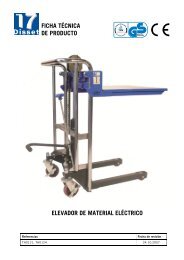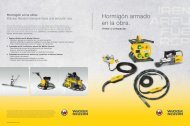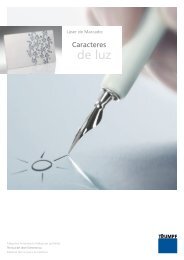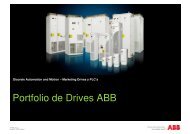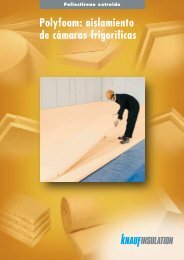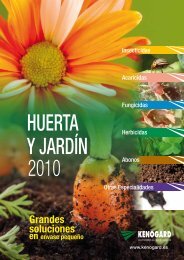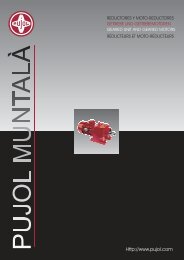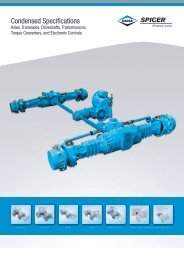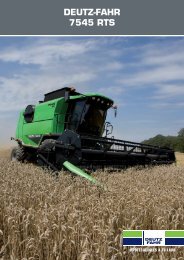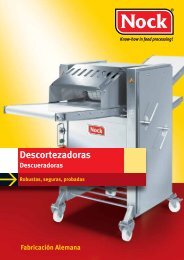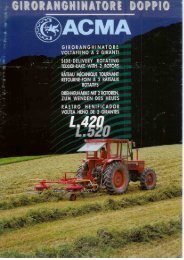ENERGIA PERMANENTE S P R A Z N E T C ... - Interempresas
ENERGIA PERMANENTE S P R A Z N E T C ... - Interempresas
ENERGIA PERMANENTE S P R A Z N E T C ... - Interempresas
Create successful ePaper yourself
Turn your PDF publications into a flip-book with our unique Google optimized e-Paper software.
20<br />
TAMBURI MAGNETICI DT<br />
Art. 602<br />
Tamburi magnetici<br />
I tamburi magnetici permanenti permettono la separazione continua ed automatica di materiale<br />
ferroso. Sono composti da un nucleo magnetico orientabile interno, da fissare opportunamente.<br />
La camicia esterna, in acc. inox, ruota trascinandosi il materiale ferroso, per poi rilasciarlo in un<br />
cassetto di raccolta.<br />
Il tamburo magnetico é il separatore più versatile in quanto può catturare ferro di piccola e grossa<br />
pezzatura. Su richiesta realizziamo modelli denominati CMD completi di eventuale tramoggia e<br />
alimentatori vibranti a uno o più tamburi.<br />
Vengono generalmente posizionati in corrispondenza di scivoli, e piani vibranti. Per applicazioni<br />
speciali si possono realizzare con magneti in neodimio (potenza più che raddoppiata), o con un<br />
circuito elettromagnetico (per inserimento/disinserimento a distanza).<br />
Tambores magnéticos<br />
Los tambores magnéticos permanentes permiten la separación continua y automática de material<br />
férrico. Están compuestos por un núcleo magnético regulable interno, que hay que fijar oportunamente.<br />
La camisa externa, en acero inoxidable, gira arrastrando consigo el material férrico, para<br />
dejarlo caer después en un cajón de recogida. El tambor magnético es el separador más versátil, ya<br />
que puede capturar hierro de grande o de pequeño tamaño.<br />
Se colocan generalmente en correspondencia de rampas, y plataformas vibradoras. Para aplicaciones<br />
especiales se pueden realizar con con imanes en neodimio (potencia reduplicada), o con un<br />
circuito electromagnético (para inserción/desinserción a distancia).<br />
Tambours magnétiques<br />
Les tambours magnétiques permanents permettent de réaliser la séparation continue et automatique<br />
des matériaux ferreux. Ils se composent d’un noyau magnétique réglable. La chemise externe<br />
rotative en acier inoxydable entraîne les matériaux ferreux qu’elle fait ensuite tomber dans un tiroir<br />
de récolte. Le tambour magnétique est le séparateur le plus éclectique car il est à même de capturer<br />
toutes les dimensions de fer.<br />
Ils sont positionnés généralement en association avec des goulottes et/ou des plans vibrants. Pour<br />
des applications spéciales ils peuvent être réalisés avec des aimants en néodyme (puissance plus<br />
que doublée), ou avec un circuit électromagnétique (pour connexion/déconnexion à distance).<br />
Magnetic tambour<br />
The permanent magnetic drums allow the continuous and automatic separation of ferrous material.<br />
They consist of an inner adjustable magnetic core , to be properly fixed. The stainless steel outer<br />
liner rotates carrying out ferrous material with it and then leaving it fall down into a collecting box.<br />
The magnetic drum is the most versatile separator, since it can deferrize both small and big sized<br />
iron. Which are generally placed near chutes and vibrating teeder.<br />
For special applications it is possible to use neodymium magnets (double power obtained), or<br />
electromagnetic circuit (for remote connection/disconnection).<br />
Magnettrommeln<br />
Die Dauermagnettrommeln ermöglichen eine dauernde und automatische Trennung von eisenhaltigem<br />
Material. Sie bestehen aus einem verstellbaren Magnetkern im Inneren, der entsprechend zu<br />
befestigen ist. Der äußere Mantel aus rostfreiem Stahl dreht sich und zieht dabei das eisenhaltige<br />
Material mit sich, um es dann eventuell in einen Sammelkasten fallen zu lassen.<br />
Die Magnettrommel ist der vielseitigste Trenner, da er Eisen in großer und kleiner Stückelung<br />
einfangen kann. Die Drehung der Trommeln erfolgt durch eine Zugrille, die auf den Flanschen<br />
(Ausführung “G”) angebracht wurde oder durch Zug mit Nabe, ausgestattet mit Keil (Ausführung<br />
“M”); sie werden normalerweise in der Nähe von Rutschen und vibrierenden Flächen positioniert.<br />
Für Spezialanwendungen können Magnete aus Neodym (mehr als verdoppelte Leistung) mit einem<br />
elektromagnetischen Kreislauf für das Ein-und Ausschalten auf Entfernung oder.<br />
Tabella portate • Capacity table<br />
ø mm Giri/ 1<br />
RPM<br />
220 31<br />
300 28<br />
400 23<br />
500 22<br />
Principio di funzionamento<br />
Principio de funcionamiento • Principe de fonctionnement<br />
Working principle • Arbeitsprinzip<br />
Ferro • Hierro<br />
Iron • Fer<br />
Eisen<br />
Spessore materiale sul tamburo mm<br />
Espesor del material en el tambor magnético milímetros/ Épaisseur du matériau sur le tambour magnétique mm de<br />
Thickness of the material on the magnetic drum mm/ Dicke des Materials auf der Magnettrommel mm<br />
portata materiale m/ 3 h x=1000 mm<br />
Capacidad material o deferrizatio m/ 3 X=1000 mm/ Capacité du matériel ou deferrizatio m/ 3 X=1000 mm<br />
Capacity material or deferrizatio m/ 3 X=1000 mm/ Kapazität Material oder deferrizatio m/ 3 5 10 20 30 40 50 60 80<br />
X=1000 mm<br />
6 12 24 36 48 60 - -<br />
8<br />
16 32<br />
48 64 80 96 -<br />
9<br />
18 36<br />
54 72 90 108 144<br />
10 20 40<br />
60 80 100 120 160<br />
Altro materiale<br />
Other material • Autre matériel<br />
Sonstige • Werkstoffe



